《介孔碳材料》PPT课件
- 格式:ppt
- 大小:5.81 MB
- 文档页数:1
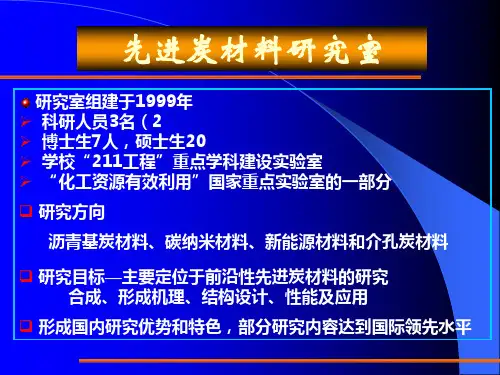
![[课件]介孔材料简介PPT](https://uimg.taocdn.com/12f52c6ff7ec4afe04a1df50.webp)


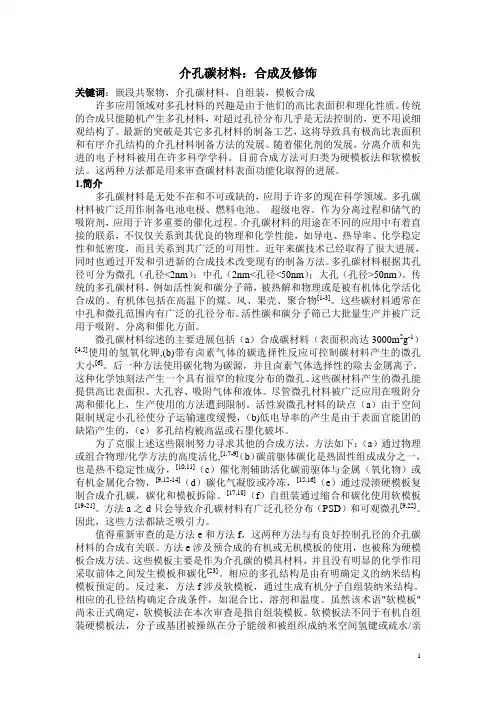
介孔碳材料:合成及修饰关键词:嵌段共聚物,介孔碳材料,自组装,模板合成许多应用领域对多孔材料的兴趣是由于他们的高比表面积和理化性质。
传统的合成只能随机产生多孔材料,对超过孔径分布几乎是无法控制的,更不用说细观结构了。
最新的突破是其它多孔材料的制备工艺,这将导致具有极高比表面积和有序介孔结构的介孔材料制备方法的发展。
随着催化剂的发展,分离介质和先进的电子材料被用在许多科学学科。
目前合成方法可归类为硬模板法和软模板法。
这两种方法都是用来审查碳材料表面功能化取得的进展。
1.简介多孔碳材料是无处不在和不可或缺的,应用于许多的现在科学领域。
多孔碳材料被广泛用作制备电池电极、燃料电池、超级电容。
作为分离过程和储气的吸附剂,应用于许多重要的催化过程。
介孔碳材料的用途在不同的应用中有着直接的联系,不仅仅关系到其优良的物理和化学性能,如导电、热导率、化学稳定性和低密度,而且关系到其广泛的可用性。
近年来碳技术已经取得了很大进展,同时也通过开发和引进新的合成技术改变现有的制备方法。
多孔碳材料根据其孔径可分为微孔(孔径<2nm);中孔(2nm<孔径<50nm);大孔(孔径>50nm)。
传统的多孔碳材料,例如活性炭和碳分子筛,被热解和物理或是被有机体化学活化合成的。
有机体包括在高温下的煤、风、果壳、聚合物[1-3]。
这些碳材料通常在中孔和微孔范围内有广泛的孔径分布。
活性碳和碳分子筛已大批量生产并被广泛用于吸附、分离和催化方面。
微孔碳材料综述的主要进展包括(a)合成碳材料(表面积高达3000m2g-1)[4,5]使用的氢氧化钾,(b)带有卤素气体的碳选择性反应可控制碳材料产生的微孔大小[6]。
后一种方法使用碳化物为碳源,并且卤素气体选择性的除去金属离子。
这种化学蚀刻法产生一个具有很窄的粒度分布的微孔。
这些碳材料产生的微孔能提供高比表面积、大孔容、吸附气体和液体。
尽管微孔材料被广泛应用在吸附分离和催化上,生产使用的方法遭到限制。
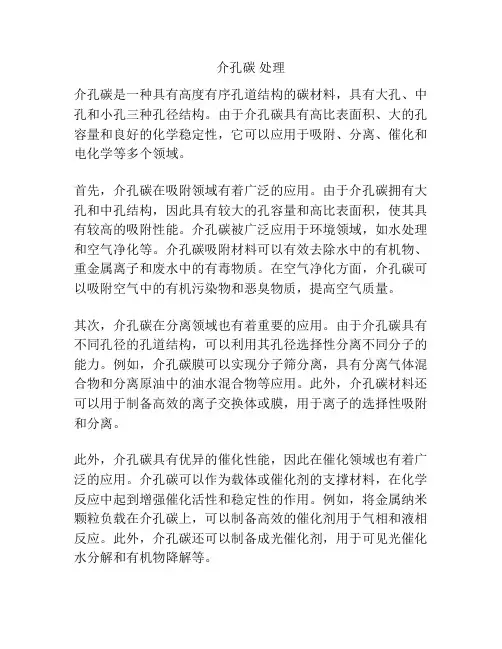
介孔碳处理介孔碳是一种具有高度有序孔道结构的碳材料,具有大孔、中孔和小孔三种孔径结构。
由于介孔碳具有高比表面积、大的孔容量和良好的化学稳定性,它可以应用于吸附、分离、催化和电化学等多个领域。
首先,介孔碳在吸附领域有着广泛的应用。
由于介孔碳拥有大孔和中孔结构,因此具有较大的孔容量和高比表面积,使其具有较高的吸附性能。
介孔碳被广泛应用于环境领域,如水处理和空气净化等。
介孔碳吸附材料可以有效去除水中的有机物、重金属离子和废水中的有毒物质。
在空气净化方面,介孔碳可以吸附空气中的有机污染物和恶臭物质,提高空气质量。
其次,介孔碳在分离领域也有着重要的应用。
由于介孔碳具有不同孔径的孔道结构,可以利用其孔径选择性分离不同分子的能力。
例如,介孔碳膜可以实现分子筛分离,具有分离气体混合物和分离原油中的油水混合物等应用。
此外,介孔碳材料还可以用于制备高效的离子交换体或膜,用于离子的选择性吸附和分离。
此外,介孔碳具有优异的催化性能,因此在催化领域也有着广泛的应用。
介孔碳可以作为载体或催化剂的支撑材料,在化学反应中起到增强催化活性和稳定性的作用。
例如,将金属纳米颗粒负载在介孔碳上,可以制备高效的催化剂用于气相和液相反应。
此外,介孔碳还可以制备成光催化剂,用于可见光催化水分解和有机物降解等。
最后,在电化学领域,介孔碳也具有重要的应用潜力。
由于介孔碳具有大孔和中孔结构,具有较高的导电性和良好的电化学稳定性,可以用作电极材料。
例如,将介孔碳用作锂离子电池的负极材料,可以提高电池的放电性能和循环寿命;同时,介孔碳还可以用于制备超级电容器电极材料,具有高能量密度和高功率密度的特点。
综上所述,介孔碳在吸附、分离、催化和电化学等多个领域具有重要的应用潜力。
介孔碳的有序孔道结构和优异性能为其在各个应用领域的研究和开发提供了广阔的空间。
随着科学技术的不断发展,相信介孔碳材料将在更多领域展现出重要的应用价值。

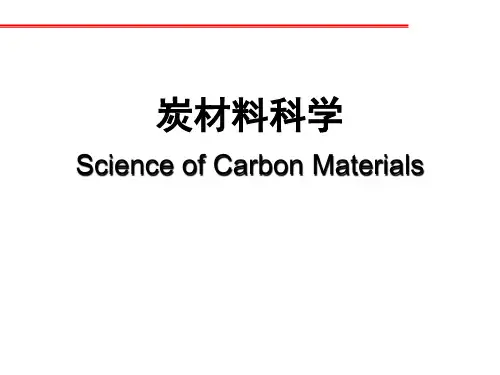
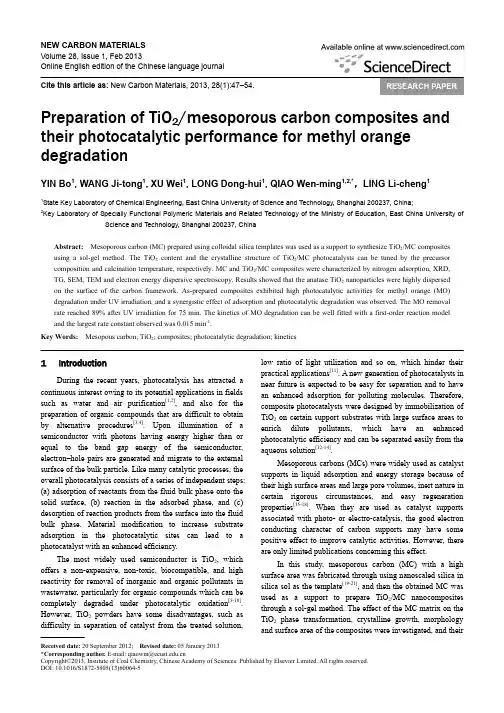
NEW CARBON MATERIALSVolume 28, Issue 1, Feb 2013Online English edition of the Chinese language journalReceived date: 20 September 2012; Revised date: 05 January 2013 *Corresponding author. E-mail: qiaowm@Copyright©2013, Institute of Coal Chemistry, Chinese Academy of Sciences. Published by Elsevier Limited. All rights reserved. DOI: 10.1016/S1872-5805(13)60064-5Preparation of TiO 2/mesoporous carbon composites and their photocatalytic performance for methyl orange degradationYIN Bo 1, WANG Ji-tong 1, XU Wei 1, LONG Dong-hui 1, QIAO Wen-ming 1,2,*,LING Li-cheng 11State Key Laboratory of Chemical Engineering, East China University of Science and Technology, Shanghai 200237, China;2Key Laboratory of Specially Functional Polymeric Materials and Related Technology of the Ministry of Education, East China University ofScience and Technology, Shanghai 200237, ChinaAbstract: Mesoporous carbon (MC) prepared using colloidal silica templates was used as a support to synthesize TiO 2/MC composites using a sol-gel method. The TiO 2 content and the crystalline structure of TiO 2/MC photocatalysts can be tuned by the precursor composition and calcination temperature, respectively. MC and TiO 2/MC composites were characterized by nitrogen adsorption, XRD, TG, SEM, TEM and electron energy dispersive spectroscopy. Results showed that the anatase TiO 2 nanoparticles were highly dispersed on the surface of the carbon framework. As-prepared composites exhibited high photocatalytic activities for methyl orange (MO) degradation under UV irradiation, and a synergistic effect of adsorption and photocatalytic degradation was observed. The MO removal rate reached 89% after UV irradiation for 75 min. The kinetics of MO degradation can be well fitted with a first-order reaction model and the largest rate constant observed was 0.015 min -1.Key Words: Mesopous carbon; TiO 2; composites; photocatalytic degradation; kinetics1 IntroductionDuring the recent years, photocatalysis has attracted a continuous interest owing to its potential applications in fields such as water and air purification [1,2], and also for the preparation of organic compounds that are difficult to obtain by alternative procedures [3,4]. Upon illumination of a semiconductor with photons having energy higher than or equal to the band gap energy of the semiconductor, electron–hole pairs are generated and migrate to the external surface of the bulk particle. Like many catalytic processes, the overall photocatalysis consists of a series of independent steps: (a) adsorption of reactants from the fluid bulk phase onto the solid surface, (b) reaction in the adsorbed phase, and (c) desorption of reaction products from the surface into the fluid bulk phase. Material modification to increase substrate adsorption in the photocatalytic sites can lead to a photocatalyst with an enhanced efficiency.The most widely used semiconductor is TiO 2, which offers a non-expensive, non-toxic, biocompatible, and high reactivity for removal of inorganic and organic pollutants in wastewater, particularly for organic compounds which can be completely degraded under photocatalytic oxidation [5-10]. However, TiO 2 powders have some disadvantages, such as difficulty in separation of catalyst from the treated solution,low ratio of light utilization and so on, which hinder their practical applications [11]. A new generation of photocatalysts in near future is expected to be easy for separation and to have an enhanced adsorption for polluting molecules. Therefore, composite photocatalysts were designed by immobilization of TiO 2 on certain support substrates with large surface areas to enrich dilute pollutants, which have an enhanced photocatalytic efficiency and can be separated easily from the aqueous solution [12-14].Mesoporous carbons (MCs) were widely used as catalyst supports in liquid adsorption and energy storage because of their high surface areas and large pore volumes, inert nature in certain rigorous circumstances, and easy regeneration properties [15-18]. When they are used as catalyst supports associated with photo- or electro-catalysis, the good electron conducting character of carbon supports may have some positive effect to improve catalytic activities. However, there are only limited publications concerning this effect.In this study, mesoporous carbon (MC) with a high surface area was fabricated through using nanoscaled silica in silica sol as the template [19-21], and then the obtained MC was used as a support to prepare TiO 2/MC nanocomposites through a sol-gel method. The effect of the MC matrix on the TiO 2 phase transformation, crystalline growth, morphology and surface area of the composites were investigated, and theiractivities towards the degradation of a model organic (methyl orange, MO) in aqueous solutions were also evaluated.2Experimental2.1 Preparation of mesoporous carbonMesoporous carbon (MC) was prepared through a template method[22]. 13 g Resorcinol (R) and 19 g formaldehyde (F, 37 mass%) were directly dissolved in deionized water with a molar ratio of 1:2. The silica sol with 7 nm silica (30 mass%, Aldrich) was added with a mass ratio of silica to RF polymer of 1:1. The mixture was sealed in 100 mL bottle, and then aged at 85 o C for 5 d in a water-bath to obtain hydrogel. After aged, the hydrogel was dried in air at 80 o C for24 h, and then carbonized under N2 flow at 800 o C for 3 h witha heating rate of 5 o C/min. The resulting mesoporous carbon was obtained through etching of silica in the carbonized composites with NaOH for 24 h.2.2 Preparation of TiO2 and TiO2/MC nanocompositesPure TiO2 catalyst was prepared through sol-gel method with using tetrabutyl titanate as a titaniaum precursor[23]. 4.25 mL tetrabutyl titanate and 6.4 ml absolute ethyl alcohol were mixed to form solution A, which was added drop-wise to the solution B containing 6.4 mL absolute ethyl alcohol, 1.2 mL alacial acetic acid and 9.6 mL deionized water under stirring. The resulting transparent yellowish TiO2-sol was stirred for 6 h, and aged for 24 h until the formation of wet gel. Then, the wet gel was dried in vacuum at 80 o C for 24 h, and finally calcined under N2 atmosphere at 450 o C for 3 h to obtain nanoscaled TiO2 powders. The TiO2/MC nanocomposites were prepared by adding a required amount of mesoporous carbon to the TiO2-sol at a certain viscosity during stirring, followed by calcination. The obtained sample was denoted as nTiO2/MC-T, in which n is mass fraction of TiO2 to MC, and T is calcination temperature[24, 25].2.3 Structural characterizationPorous properties of the samples were characterized via the nitrogen adsorption at 77 K (Quadrasorb SI-MP, Quanta, USA). Before analysis, the samples were dried at 200 °C, and evacuated overnight under vacuum. The surface areas of the samples were calculated using the Brunauer-Emmett-Teller (BET) method, and the total pore volumes were determined by the amount of nitrogen adsorbed at P/P0=0.985. The average pore sizes were obtained from desorption data through Barrett-Joyner-Halenda (BJH) method. Elementary analysis of 50%TiO2/MC-450 composite was carried out by Energy disperse spectroscopy (EDS, Falion60s, EDAX, USA). Thermogravimetric analyses (TGA) of the samples were performed by a Thermogravimetric analyzer (SDT-Q600, TA, USA) with a heating rate of 10 °C/min under air with a flow rate of 100 mL/min. The crystal structures of the samples were characterized through X-ray diffraction (XRD, D/max 2 550V, Rigaku, Japan) with Cu Kα radiation (α=1.54 060 Å) from 10° to 80° with a scanning speed of 0.02 °/s. X-ray tube voltage and current were set at 40 kV and 20 mA, respectively. The morphologies of the samples were observed under Scanning electron microscopy (SEM, S-4800, Hitachi, Japan) and Transmission electron microscopy (TEM, JEM2100, JEOL, Japan).2.4 Photocatalytic activity measurementsMethyl orange (MO) was used as a model compound to investigate the photocatalytic activity of samples with an initial concentration of 100 mg/L in aqueous solution. The reactions were carried out in a quartz glass vessel and the reactor was irradiated by UV light (220-400 nm) from xenon lamp (PLS-SXE300UV, Cermax, USA) located directly above the vessel at a distance of 5 cm from the liquid surface. Before the irradiation, adsorptive property of samples was investigated in a complete dark. The concentrations of the aqueous MO solution during degradation and adsorption treatment were determined with a UV-vis spectrometer (T6, Persee, China) by measuring the absorbance at 465 nm.3Results and discussion3.1 Porous properties of MC and TiO2/MC samplesFig. 1 showed N2 adsorption isotherms and pore size distributions of MC and TiO2/MCs. All samples exhibited a typical IV type isotherm with a H1 hysteresis loop as shown in Fig. 1a, indicating the samples are mainly mesoporous [26].Fig. 1 (a) N2 adsorption/desorption isotherms and (b)pore size distributions of MC and TiO2/MC composites.Table 1 Porous parameters for MC, TiO2 powder and TiO2/MCS BET v t D pSamples /m2·g-1 /cm3·g-1 /nmMC 811 1.68.1 10%TiO2/MC-450 667 1.2 7.330%TiO2/MC-450 531 1.0 7.850%TiO2/MC-450 442 0.8 7.670%TiO2/MC-450 266 0.5 8.0 TiO2 363 0.3 3.1 Note:S BET: BET surface area; v t: total pore volume;D p: average pore diameter.The presence of TiO2 nanoparticles almost does not affect the type of isotherms and the connectivity of MC network should remain unchanged. The similar results could be reached from the pore size distributions as shown in Fig. 1b. The porous parameters of these samples were summarized in Table 1. With the increase of TiO2 content from 0.1 to 0.7 in the composite, the surface areas and total pore volumes of composite catalysts decrease from 667 m2/g and 1.23 cm3/g to 266 m2/g and 0.53 cm3/g, respectively.3.2 Thermogravimetric analyses of MC and TiO2/MC samplesFig. 2 showed the weight loss of MC, TiO2-450 and TiO2/MC nanocomposites up to 900 o C under air. The TGA curve of 50%TiO2/MC-450 exhibits a remarkable weigh loss from 400 to 580 °C, which corresponded to the oxidation of MC support. The combustion point of MC in the composite is found to be 520 °C, which is determined at the temperature with the highest rate of weight loss. Conversely, the pure MC does not combust until about 600 °C. This shift might be ascribed to the presence of metal oxides grafted on the surfaceof MC, which may provide oxygen required by the reaction and/or restrained the heat transfer creating partial hot spots, facilitating the combustion of carbon. The curves shown in Fig. 2 also suggest that the TiO2/MC ratios estimated before the synthesis of the composite catalysts are in close agreement with the results obtained from TGA analyses.3.3 X-ray diffraction of the samplesFig. 3 showed XRD patterns of MC support, pure TiO2 powder and 50%TiO2/MC composites heat-treated at different temperatures. Two broad peaks at 24° (2θ) and 43° (2θ) are characteristic of graphitic crystalline of MC. The pure TiO2 calcined at 450 °C exhibits a mixed crystal structure of anatase and rutile. It is well known that the calcination improves the crystallinity of pure TiO2 with increasing temperature. As a result, the amorphous TiO2 changes to the anatase phase and further to rutile phase. However, in this study, the TiO2 deposited on MC calcined still retained the structure of anatase at the temperatures even up to 750 o C without rutile peak. It is therefore suggested that TiO2/MC nanocomposites have a good thermal stability, which could be ascribed to the high surface area of MC where TiO2 nanoparticles were well dispersed. The interfacial interaction between TiO2 and MC could restrain the transformation of TiO2 from anatase to rutile phase.In addition, the peaks at 25.4° (2θ) become gradually sharp, with increasing calcination temperature from 350 to 750°C, implying that TiO2 nanoparticles grow large and crystals trend to perfect anatase. Generally, the full width at half maximum of XRD peak is related to the particle size of crystal materials. The larger the width, the smaller the crystalline size is. The mean sizes of a single crystallite can be estimated from the full-width at half-maxima of XRD peaks by using Scherrer’s formula[27]. The average sizes of pure TiO2 powder and the nanocomposites calcinated at different temperatures are listed in Table 2. It is evident that the crystal size of pure TiO2 is larger than that in the nanocomposites calcined at the same temperature. The crystal size of TiO2 in the nanocomposites increases with increasing calcination temperatures, suggesting that high temperature leads to TiO2 crystal growth without transformation of crystal phase. The result indicates that as-deposited anatase TiO2 nanoparticles are stable.Fig. 2 TGA curves of samplesFig. 3 X-ray diffraction patterns of (a) MC, (b) pure TiO2 calcined at 450 ℃, (c) 50%TiO2/MC-350, (d) 50%TiO2/MC-450,(e)50%TiO2/MC-550, (f) 50%TiO2/MC-650 and(g) 50%TiO2/MC-750.Table 2 Average sizes of TiO 2 particles and TiO 2/MC nanocomposites3.4 Morphology of MC, TiO 2, and TiO 2/MC samples Figs.4a, 4b and 4c illustrated SEM images of MC, 50%TiO 2/MC-450 and pure TiO 2 powder respectively. It is remarkable that MC is a highly porous material, and pure TiO 2 is an aggregate of irregular nanoparticles with size of ca. 15 nm. After coated on surface of MC, the TiO 2 particles are found to be well-dispersed. Additionally, it appears that the MC could act as a barrier that inhibits the growth of the TiO 2 particles to a certain extent. The composition of the nanocomposite is analyzed by EDS as shown in Fig. 4d, which reveals the presence of Ti and O on the surface of MC.Fig. 5 showed that SEM images of MC, 50%TiO 2/MC-450 and pure TiO 2 powder. Being similar to the results from SEM observation, TEM observation providessome visible information about the TiO 2 nanoparticles deposited in the pores of MC. As shown in Fig. 5a, MC exhibits randomly distributed and interconnected spherical pores, which are uniform with a size of ca. 8 nm, being consistent with the diameter of SiO 2 particles. This indicates that mesopores of MC are exclusively generated by the closely packed SiO 2 particles. Pure TiO 2 aggregates (Fig. 5b) are made up of nanoparticles with the size of ca. 15 nm. As shown in Figs. 5c and 5d, 50%TiO 2/MC-450 nanocomposite shows that TiO 2 nanoparticles are embedded within the pores of MC, and a lattice spacing of 0.333 nm corresponding to (110) plane of anatase can be observed. The distribution of the nanoparticles was relatively homogenous, and the interconnected structure of the mesopores is still preserved. 3.5 Adsorption and photocatalytic activity of MC, TiO 2 and TiO 2/MC samplesThe activities of the TiO 2/MC nanocomposites were evaluated by the photodegradation of MO aqueous solutionunder UV irradiation. As a comparison, pure TiO 2 was prepared and its activity was also measured under the sameconditions. Fig. 6 showed the photocatalytic degradation rates of MO by the TiO 2/MC nanocomposites and pure TiO 2 at 465 nm. Compared with the removal rates of pure MC adsorption and TiO 2 photocatalytic degradation, the removal rates of MO over the TiO 2/MC nanocomposites are much high, owing to the synergetic effect of adsorption and photocatalyticFig. 4 SEM images of (a) MC, (b) 50%TiO 2/MC-450, (c) TiO 2 and the EDS curve (d) of 50%TiO 2/MC-450.Fig. 5 TEM images of (a) MC, (b) TiO 2, (c, d) 50%TiO 2/MC-450.Samples 50%TiO 2/MC-35050%TiO 2/MC-45050%TiO 2/MC-55050%TiO 2/MC-65050%TiO 2/MC-750 TiO 2-450D TiO2/nm 11.8 12.413.314.915.4 13.0Fig. 6 Degradation rates of MO by MC and the nanocomposites with irradiation started at 0 min and material to solution ratio of pure TiO2at 1 g/L, 10%TiO2/MC-450 at 0.56 g/L, 30%TiO2/MC-450 at 0.6 g/L, 50%TiO2/MC-450 at 1 g/L, and 70%TiO2/MC-450 at 1.66 g/L, corresponding to a constant weight of MC in solutions.degradation. It can be found that the activity of MO degradation is in the order of 50%TiO2/MC-450 > 70%TiO2/MC-450 > 30%TiO2/MC-450 > 10%TiO2/MC-450 > TiO2. Such results indicate that MO conversion increases with increasing TiO2 content of the nanocomposites except for 70%TiO2/MC-450, and the conversion of MO by 50%TiO2/MC-450 could reach 89% after UV irradiation for 75 min. The activity reduction of 70%TiO2/MC-450 compared with that of 50%TiO2/MC-450 might be ascribed to the decrease of surface area. 10%TiO2/MC-450 showed a low photocatalytic activity, and this might be caused by the limited TiO2 loaded on the surface of MC. In this case, the photocatalytic reaction could hardly be driven by UV light and the removal of MO is mainly caused by adsorption.Besides TiO2 contents, the photocatalytic activity of the TiO2/MC nanocomposites calcinated at different temperatures was also evaluated. Fig. 7 illustrated degradation rates of MO by the nanocomposites with different calcination temperatures from 350 to 750 o C. It can be found that the activity of MO degradation is in the order of 50%TiO2/MC-450 > 50%TiO2/MC-550 > 50%TiO2/MC-750 > 50%TiO2/MC-650 > 50%TiO2/MC-350. It is suggests that the photocatalytic activity be related to both pore structure and crystal structure of the nanocomposites. Generally, the smaller the particle size, the higher the activity TiO2 is. In this study, the sample calcinated at 450 o C exhibits the highest activity, implying that the calcination temperature of 450 °C is crucial. But the activity of 50%TiO2/MC-750 is higher than that of 50%TiO2/MC-650, which has a smaller particle size, suggesting that the crystal structure might be more important than crystal particle size.The activity of the photocatalyst is mainly dependent on the surface area, crystalline size, crystallinity and the support structure. Firstly, the three-dimensionally interconnected pore structures facilitate the diffusion of reactants and products from the active sites during the photocatalytic reaction, and a higher surface area of composites provides a higher adsorption capacity of reactive species[28], which increases the local concentration of reactive species near active sites, and as a result, improves the reaction rates. The degradation of polluting molecules on the surface of photocatalyst is achieved with the participation of photogenerated electrons and holes, which are more likely to recombine at defect sites on the surface of TiO2. Therefore, the photocatalytic efficiency can be improved by suppressing the recombination rate of photogenerated electrons and holes[29]. When TiO2 is coated on MC, the formation of TiO2/MC hetero-junctions and excellent electron conductivity of the carbon support facilitates the transfer of photogenerated electrons from TiO2 to carbon support, and reduces the recombination rate of electrons and holes [30]. Moreover, the improved crystallinity of TiO2 with less defect sites in MC could reduce the probability of the recombination of electrons and holes. All these factors lead to an improved activity of the TiO2/MC nanocomposites as catalysts in the degradation of MO aqueous solution.3.6 Photocatalytic kinetics of TiO2/MC samplesIt is well known that decomposition of MO in water by UV/TiO2 can be adequately described by a first-order kinetic model. Therefore, the apparent rate constant was chosen as the basic kinetic parameter for an activity comparison of the different photocatalysts [31].The apparent first-order kinetic equation ln(C0/C) =kt was used to fit experimental data, where k is apparent rate constant, C is the MO concentration in solution phase, and C0 is the initial concentration at t=30 min as catalysts reached adsorption equilibrium after 30 min [32]. Fig. 8 showed kinetic curves of the nanocomposites with different calcination temperatures for the degradation of MO under UV irradiation.The linear transform in ln(C0/C) as a function of irradiation time confirms the apparent first-order reaction kinetic characteristic. The slope of ln C0/C versus time plot gives the value for the rate constant k as listed in Table 3. SuchFig. 7 Degradation rates of MO by the nanocomposites with different calcination temperatures with a catalyst to solution ratio of 1 g/Lunder dark and UV irradiation.Fig. 8 Kinetic curves of the nanocomposites with different calcinationtemperatures for degradation of MO under UV irradiation.Table 3 Reaction kinetic constant of TiO 2/MC samplesSampleApparent kinetic constant /min -10.5TiO 2/MC-350 0.004 0.5TiO 2/MC-450 0.0120.5TiO 2/MC-550 0.015 0.5TiO 2/MC-650 0.005 0.5TiO 2/MC-750 0.009results show that the sample calcined at 550 °C exhibits thefastest reaction rate.4 ConclusionsMesoporous carbon with a high surface area and a large pore volume was used as a support for TiO 2 nanoparticles to prepare TiO 2/MC photocatalysts through a sol-gel method. After TiO 2 loading, both surface area and pore volume were decreased, and the thermal stability of TiO 2 crystallites increased. The experimental results showed that TiO 2/MC nanocomposites exhibit higher activities than pure TiO 2 for the removal of methyl orange. The optimal weight ratio of TiO 2 to MC in the nanocomposites and calcination temperature required was determined to be 50% and 450 °C, respectively. The dispersion of TiO 2 in the nanocomposites is good, and a synergistic effect of adsorption and degradation for the catalytic activity is emphasized. The MO removal rate of TiO 2/MC reached 89% after a UV irradiation for 75 min. The kinetics of MO degradation can be fitted well with the first-order reaction model and the largest rate constant is 0.015 min -1 for the 50%TiO 2/MC-550 nanocomposite. AcknowledgmentsThis work was partly supported by National Science Foundation of China (No. 20977028; No. 51172071), Technology Talent Foundation of Shanghai (11XD1401800), Fundamental Research Funds for the Central Universities, and the Research Fund for the Doctoral Program of Higher Education (No. 20090074110009).References[1]Alfano O M ,Bahnemann D ,Cassano A E ,et al. Photocatalysis in water environments using artificial and solar light [J]. Catalysis Today ,2000, 58(2-3: 199-230. [2]Kitano M, Matsuoka M, Ueshima M, et al. Recent developments in titanium oxide-based photocatalysts [J]. Applied Catalysis A, General ,2007, 325(1): 1-14. [3]Fagnoni M, Dondi D, Ravelli D, et al. Photocatalysis for the formation of the C-C bond [J]. Chemical Reviews ,2007, 107(6): 2725-2756. [4] Albini A ,Fagnoni M. Some applications of photocatalysis [J]. Chimica Oggi-Chemistry Today ,2004,22(9): 36-38. [5]Linsebigler A L, Lu G , Yates J T. Photocatalysis on TiO 2 surfaces :Principles ,mechanisms ,aselected results [J] . Chemical Reviews ,1995, 95(3): 735-758. [6]Fujishima A, Rao T N, Tryk D A. Titanium dioxide photocatalysis [J]. Journal of Photochemistry and Photobiology C :Photochemistry Reviews ,2000, 1(1): 1-21. [7]Mills A, Le H S. An overview of semiconductor photocatalysis [J]. Journal of Photochemistry and Photobiology A :Chemistry ,1997, 108(1): 1-35.[8] Herrmann J M. Heterogeneous photocatalysis : Fundamentals and applications to the removal of various types of aqueous pollutants [J]. Catalysis Today ,1999, 53(1): 115-129. [9]Addamo M, Augugliaro V , Di P A, et al. Preparation, characterization ,and photoactivity of polycrystalline nanostructured TiO 2 catalysts [J]. Journal of Physical Chemistry B, 2004, 108(10): 3303-3310.[10] Kansal S K ,Singh M ,Sud D. Studies on photodegradation oftwo commercial dyes in aqueous phase using different photocatalysts [J]. Journal of Hazardous Materials ,2007, 141(3): 581-590.[11] Wang X ,Hu Z ,Chen Y ,et al. A novel approach towardshigh-performance composite photocatalyst of TiO 2 deposited on activated carbon [J]. Applied Surface Science ,2009, 255(7): 3953-3958.[12] Bouzaza A, Laplanche A. Photocatalytic degradation of toluenein the gas phase :Comparative study of some TiO 2 supports [J]. Journal of Photochemistry and Photobiology A :Chemistry ,2002, 150(1-3): 207-212.[13] Mahmoodi N M ,Arami M ,Limaee N Y . Photocatalyticdegradation of triazinic ring-containing azo dye (Reactive Red 198) by using immobilized TiO 2 photoreactor :Bench scale study [J]. Journal of Hazardous Materials ,2006, 133(1-3): 113-118.[14] Takeda N ,Torimoto T ,Sampath S ,et al. Effect of inert supportsfor titanium dioxide loading on enhancement of photodecomposition rate of gaseous propionaldehyde [J]. Journal of Physical Chemistry ,1995, 99(24): 9986-9991. [15] Tang Z H ,He X ,Song Y ,et al. Properties of mesoporouscarbons prepared from different carbon precursors using nanosize silica as a template [J]. New Carbon Materials ,2010, 25(6): 465-469.[16] Ryoo R ,Joo S H ,Kruk M ,et al. Ordered mesoporous carbons[J]. Advanced Materials ,2001, 13(9): 677-681.[17] Darmstadt H ,Roy C ,Kaliaguine S ,et al. Surface chemistry ofordered mesoporous carbons [J]. Carbon,2002, 40(14):2673-2683.[18]Kim D J,Lee H I,Yie J E,et al. Ordered mesoporous carbons:Implication of surface chemistry,pore structure and adsorptionof methyl mercaptan [J]. Carbon,2005, 43(9): 1868-1873. [19]Lu A H,Schmidt W,Schuth F. Simplified novel synthesis ofordered mesoporous carbon with a bimodal pore system [J].New Carbon Materials,2003, 18(3): 181-185.[20]Tang Z,Song Y,Tian Y,et al. Pore development ofthermosetting phenol resin derived mesoporous carbon througha commercially nanosized template [J]. Materials Science andEngineering: A,2008, 473(1-2): 153-157.[21]Qiao W M,Song Y,Hong S H,et al. Development ofmesophase pitch derived mesoporous carbons through a commercially nanosized template [J]. Langmuir,2006, 22(8):3791-3797.[22]Wang J T,Chen Q J,Liu X J,et al. Hard-templating synthesisof mesoporous carbon spheres with controlled particle size andmesoporous structure for enzyme immobilization [J]. MaterialsChemistry and Physics,2011,129(3):1035-1041.[23]Chantal G,Bernard B,Cedric D,et al. Physicochemicalproperties and photocatalytic activities of TiO2-films preparedby sol-gel methods [J]. Applied Catalysis B: Environmental,2002,39(4):331-342.[24]Zhang J,Huang Z H,Xu Y,et al. Carbon-coated TiO2composites for the photocatalytic degradation of low concentration benzene [J]. New Carbon Materials,2011,26(1):63-70.[25]Zhu L,Meng Z D,Cho K Y,et al. Synthesis of CdS/CNT-TiO2with a high photocatalytic activity in photodegradation ofmethylene blue [J]. New Carbon Materials 2012, 27(3):166-174.[26]Sing K S W,Everett D H,Haul R A W,et al. Reportingphysisorption data for gas/solid systems with special referenceto the determination of surface rea and porosity [J]. Pure andApplied Chemistry,1982, 54(11):2201-2218.[27]Hamdy M S,Berg O,Jansen J C,et al. TiO2 nanoparticles inmesoporous TUD-1:Synthesis,characterization and photocatalytic performance in propane oxidation [J] .Chemistry-A European Journal,2006, 12(2): 620-628. [28]Ziolkowski L, Vinodgopal K, Kamat P V. Photostabilization oforganic dyes on Poly(styrenesulfonate)-capped TiO2nanoparticles [J] . Langmuir,1997, 13(12): 3124-3128. [29]Karunagaran B,Rajendra K R T,Senthil K V,et al. Structuralcharacterization of DC magnetron-sputtered TiO2 thin filmsusing XRD and Raman scattering studies [J]. Materials Sciencein Semiconductor Processing,2003, 6(5-6): 547-550. [30]Xie Y,Yuan C. Visible-light responsive cerium ion modifiedtitania sol and nanocrystallites for X-3B dye photodegradation[J]. Applied Catalysis B:Environmental 2003, 46(2): 251-259.[31]Ao Y H,Xu J J,Fu D G,et al. Photocatalytic degradation ofX-3B by titania-coated magnetic activated carbon under UVand visible irradiation [J]. Journal of Alloys and Compounds,2009, 471(1-2): 33-38.[32]Matos J,Laine J,Herrmann J M. Synergy effect in thephotocatalytic degradation of phenol on a suspended mixture oftitania and activated carbon [J]. Applied Catalysis B:Environmental,1998, 18(3-4): 281-291.。
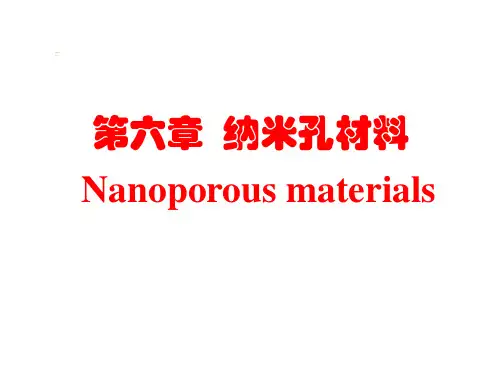
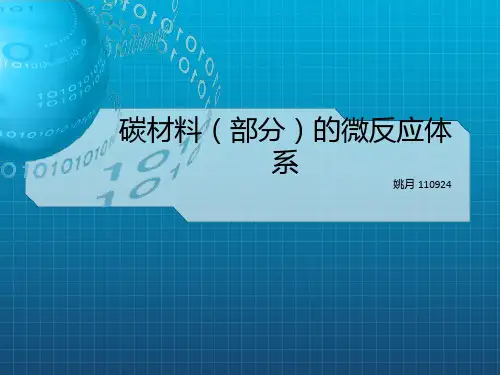
介孔碳材料的发展综述介孔碳材料是近年来新兴的一类非常重要的二维材料,它们具有独特的结构、极高的分子选择性吸附能力、优异的电学性能以及高折射率等特点,优越的物理化学性能为它们在多个应用领域发挥重要作用,从而得到了大量的研究关注与热情追捧。
在结构上,介孔碳材料由多层石墨烯堆积而成,其中介孔空隙的直径在几十到几百之间,可以容纳一定量的分子,并且表面有较多的碳环和碳双键可供乙酰胺分子牢牢结合,使得它们可以有效地吸附病原体。
此外,由于介孔碳材料的体积灵活性,空间紧凑性以及质量轻的特点,因此在传感技术、电池材料、载流子发生器和能源存储、环境保护和能源利用以及军事战术装置等方面也有着广泛的应用。
而且,介孔碳材料表面疏水性强,具有抗菌剂的抗菌作用,可以阻止细菌的增殖,减少病原体在其表面的滋生,更好地保护人们的健康。
同时,介孔碳材料具有优异的电学性能,可以有效地用于电子器件、传感器和其他电子设备的组装,从而提高电子器件的性能和可靠性。
此外,介孔碳材料可以用于构建宽带穿透红外光谱传感器。
它可以检测宽带光谱信号,可以被用来检测湿度、温度和化学物质的吸收,因此在环境监测和安全控制等领域有广泛的应用前景。
此外,介孔碳材料也可以用于气体分离和捕集,尤其是对于稀有气体的检测和捕集,介孔碳材料能够提供更高的效率。
自介孔碳材料被发现以来,它已经发展成为一种非常重要的材料,被广泛应用于传感器、电池材料、军事应用、环境监测、生物传感等领域,彻底改变了传统的材料研究以及制造工艺。
通过研究介孔碳材料的构筑方法,以及表面修饰技术,可以改善介孔碳材料的电学性能、分子选择性吸附能力以及抗菌性能,使之更适合多种应用领域,从而更加有效地提升介孔碳材料的综合性能。
此外,根据介孔碳材料的类型、构造结构以及它能够改变物质配置形式,研究者可以开发出新型介孔碳材料,从而提高它们在多种应用领域的综合性能。
综上所述,介孔碳材料已经发展成为一类重要的新型材料,具有独特的结构、优异的电学性能、优越的物理化学性能以及高折射率等特点,并且还有着广泛的应用前景,在多种应用领域发挥着重要作用。
介孔碳,脱溶剂化,负极材料下载提示:该文档是本店铺精心编制而成的,希望大家下载后,能够帮助大家解决实际问题。
文档下载后可定制修改,请根据实际需要进行调整和使用,谢谢!本店铺为大家提供各种类型的实用资料,如教育随笔、日记赏析、句子摘抄、古诗大全、经典美文、话题作文、工作总结、词语解析、文案摘录、其他资料等等,想了解不同资料格式和写法,敬请关注!Download tips: This document is carefully compiled by this editor. I hope that after you download it, it can help you solve practical problems. The document can be customized and modified after downloading, please adjust and use it according to actual needs, thank you! In addition, this shop provides you with various types of practical materials, such as educational essays, diary appreciation, sentence excerpts, ancient poems, classic articles, topic composition, work summary, word parsing, copy excerpts, other materials and so on, want to know different data formats and writing methods, please pay attention!Introduction近年来,介孔碳被广泛应用于脱溶剂化的负极材料领域,其在电池、超级电容器等领域展现出了良好的应用前景。